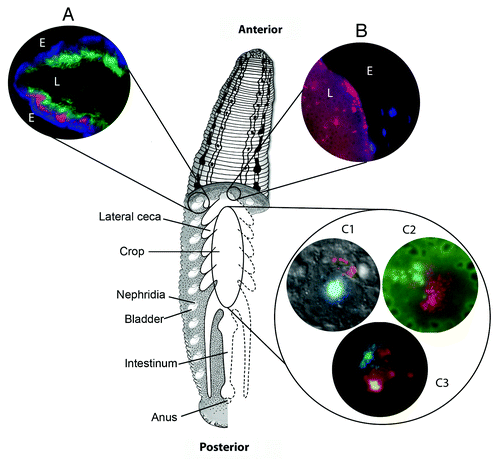Figures & data
Figure 1. Major alimentary structures and microbial interactions of Hirudo verbana. Drawing demonstrating the anatomy of Hirudo verbana showing the major structures of the alimentary system including the crop, lateral crop ceca, nephridia and bladders, intestinum, and anus. Inset images illustrate microbial interactions within the bladder (A), along the crop epithelium (B) and through the crop at large (C) and are as follows: A) FISH image showing the distribution of bacteria within the bladder lumen (colors correspond to probes targeted as follows: green = β-Proteobacteria, red = Bacteroidetes, blue = Bacteria); (B) FISH image of the Rikenella-like bacterium (red) along the crop epithelium, epithelial cell nuclei counter-stained with DAPI; (C1) composite image of Aeromonas (red) associated with the cell surface of a leech hemocyte, nucleus counter-stained with DAPI; (C2) FISH image of mixed microcolonies showing both Aeromonas (green) and the Rikenella-like bacterium (red), erythrocytes from a blood meal auto-fluoresce green and have darkened interiors; (C3) fluorescent image of lectin staining using succinylated wheat germ agglutinin (WGA-S, red) and DAPI counter-staining of bacterial colonies. For images A and B, the following indicators are used: E indicates the tissue epithelium of the bladder (A) or crop (B) and L indicates the lumen.
